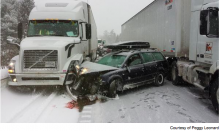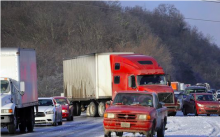Accidents
Accident Data Center focuses on providing information and resources for people who have been injured, and for the families of those killed, to make decisions and get help. While the majority of accidents we report on are car crashes, we also see all other types of accidents including bicycle, pedestrian, boating, commercial trucking, aircraft, and motorcycle accidents
Some general accident statistics illustrate why Accident Data Center exists in the first place:
Fatality accidents in 2013 nationally:
- There were 30,057 fatal crashes with 32,719 people killed;
- Fatality rate per 100,000 population was 10.35;
- Rural fatal injuries comprised 54% of all fatal injuries;
- There were 90 fatalities per day;
- There were 9,158 fatal crashes related to alcohol impairment; 28 people died per day in DUI crashes;
- 49% of people killed in accidents were unrestrained with safety belts.
Injury accidents in 2013 nationally:
- There were 5,687,000 police reported crashes with 2,313,000 people reported injured;
- Injury rate per 100,000 population was 732;
- There were 6,337 people injured per day.
While there have been great improvements made in overall safety statistics over the years, it is our wish that these accident numbers are brought down to zero. Until then, Accident Data Center will strive to provide up-to-date information, resources, and support for all those involved in accidents.
Tallahassee, FL-Thomasville, GA
Authorities reported an SUV was traveling westbound on Roberts Aman Road while a semi- truck was driving northbound on Highway 221. The driver of the SUV neglected yield to the semi-truck and pulled forward from the stop sign at the intersection of Roberts Aman Road and US HWY 221.
Lexington, KY
Authorities reported four people have died and two others have been injured after vehicle collision on the highway in Bourbon County. The wreck occured on Cane Ridge Road Friday afternoon.
After bruises fade, emotional trauma from accident can linger
Tribal Road Safety: Get the Facts
How big is the problem?
- Injuries are the leading cause of death for AI/AN ages 1 to 54 and the third leading cause of death overall. 1
The Algorithm of an Accident: A Shared Community Resource
In Tennessee Icy roads create dozens of accidents, sprawling gridlock
Police crews and emergency responders have been stretched thin Tuesday morning as drivers have taken to roads despite warnings, leaving strings of accidents that have delayed traffic for miles.
The Nashville Metropolitan Police Department reported that between 3:30 a.m. and 9:30 a.m. Tuesday officers responded to four injury crash calls and 82 non-injury crash calls.--Jordan Buie








